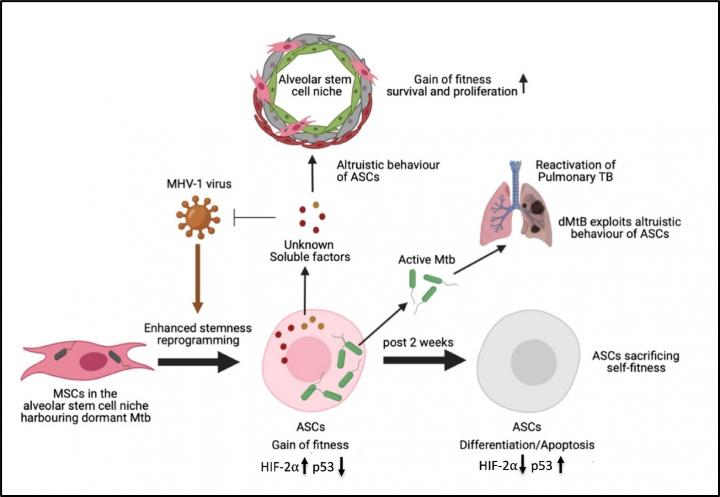Coronavirus activates a stem cell-mediated defense mechanism that reactivates dormant TB in a mouse model and has implications for developing new vaccines and avoiding a global TB pandemic, report investigators in The American Journal of Pathology
Philadelphia, June 16, 2021 – The SARS-CoV-2 virus that causes COVID-19 may have the ability to reactivate dormant tuberculosis (TB). In a novel study scientists report in The American Journal of Pathology that infection with a specific coronavirus strain reactivated dormant Mycobacterium tuberculosis (MTB) in mice. This knowledge may help to develop new vaccines for COVID-19 and avoid a potential global tuberculosis epidemic.
The COVID-19 pandemic caused by the SARS-CoV-2 virus demonstrates the ability of an emerging virus to affect masses and strain and disrupt the workings of modern healthcare systems around the world. A significant number of infected COVID-19 individuals have recovered. However, a possible host defense or antiviral mechanism against the virus is yet to be identified. There are concerns that in the long-term, the virus might activate dormant bacterial infections such as TB in select infected individuals, as alarmingly, TB is already present in one quarter of the world population. Viral infections such as the influenza virus or SARS-CoV-1 are known to cause transient immune suppression that leads to reactivation of dormant bacterial infection. The highest death rate during the Spanish flu pandemic of 1918 was in patients with TB, and patients with TB or multidrug-resistant TB had a worse prognosis than others during the influenza A (H1N1) pandemic in 2009.
“There is an urgent need to study the association of COVID-19 with dormant TB reactivation to avoid a potential global TB pandemic,” explained lead investigator Bikul Das, MD, PhD, Department of Stem Cell and Infectious Diseases, KaviKrishna Laboratory, Guwahati Biotech Park, Indian Institute of Technology, Guwahati, India; and Department of Stem Cell and Infection, Thoreau Lab for Global Health, University of Massachusetts, Lowell, MA, USA. “It is important to understand the host defense mechanism against this disease to develop a better vaccine and/or treatment. We therefore postulated that, similar to bacteria, adult stem cells may also exhibit an altruistic defense mechanism to protect their niche against external threat.”
Investigators studied the coronavirus strain murine hepatitis virus-1 (MHV-1) infection in the lung in a mouse model (dMtb) of mesenchymal stem cell (MSC)-mediated MTB dormancy. This showed 20-fold lower viral loads than the dMtb-free control mice by the third week of viral infection and a six-fold increase of altruistic stem cells (ASCs), thereby enhancing the defense. Tuberculosis was reactivated in the dMtb mice, suggesting that dormant TB bacteria hijack these ASCs to replicate in the lung to cause pulmonary TB. Results suggest that these ASCs are transient (they expand for two weeks and then undergo apoptosis or cellular suicide) and exhibit antiviral activities against MHV-1 by secreting soluble factors.
“These findings are important because they reveal a novel ASC defense mechanism against mouse coronavirus infection, which could be used to develop novel therapeutic approaches against COVID-19,” noted Bikul Das. “The finding of TB reactivation in a stem cell-mediated Mtb dormancy mouse model during MHV-1 coronavirus infection indicates that in the long-term, post-pandemic, the SARS-CoV-2 virus might activate dormant bacterial infections. This is a significant finding considering the current coronavirus pandemic, where many individuals in India and other developing countries with dormant TB infection may see an increase in active TB cases post COVID-19. The ASC-mediated defense mechanism may be targeted to develop vaccines against viral infections and avoid a potential global TB pandemic.”
###
Background notes
This study of stem cell altruism was inspired by the Indian Vedantic Philosophical theory of altruistic behavior, which was referred to in the poem “Fire of Golden Nail” written by Vedic philosopher and poet Krishna Ram Das of Kamrupa, India, noted the study’s authors. Poet Krishna Ram Das conceptualized the idea while undergoing surgery for throat cancer and initiated the KaviKrishna Foundation to test his idea through vigorous scientific research.
“Proving altruism in mammalian cell biology is a challenging task, as we faced years of resistance from colleagues,” commented Bikul Das. “Altruism is about group selection, which is very challenging to demonstrate at the molecular level. However, the idea of altruism that we are describing here is the philosophical view of Vedic Jiva Upakarvada (Vedic altruism), a part of Vedantic thought that states that during stress, the living organism acquires a higher state, known as ‘Avatar.’ The mandate of the KaviKrishna laboratory is to take this philosophical view forward to modern biology, specifically to develop a philosophical and social theory on global health.
First author Lekhika Pathak, PhD student at the KaviKrishna Lab, GBP, IIT-Guwahati, India, commented: “I joined the laboratory hoping to further ASC research exploiting the model of MHV-1-infected stem cell-mediated Mtb dormancy. Our research findings now may provide a novel approach to understand the interaction between two pathogens, coronavirus and M. tuberculosis, both of which are major threats to global health.”
Co-investigator Herman Yeger, PhD, of the Department of Pediatric Laboratory Medicine, Hospital for Sick Children, Toronto, Ontario, Canada, added: “I commend Bikul Das for being innovative in transforming a piece of Indian philosophy into a testable biological experiment on altruism. Now that we have obtained convincing data on the identification of ASC and their defense against coronavirus, we hope to develop a novel approach to tackle this growing pandemic.”
Media Contact
Eileen Leahy
[email protected]
Original Source
https:/
Related Journal Article
http://dx.





